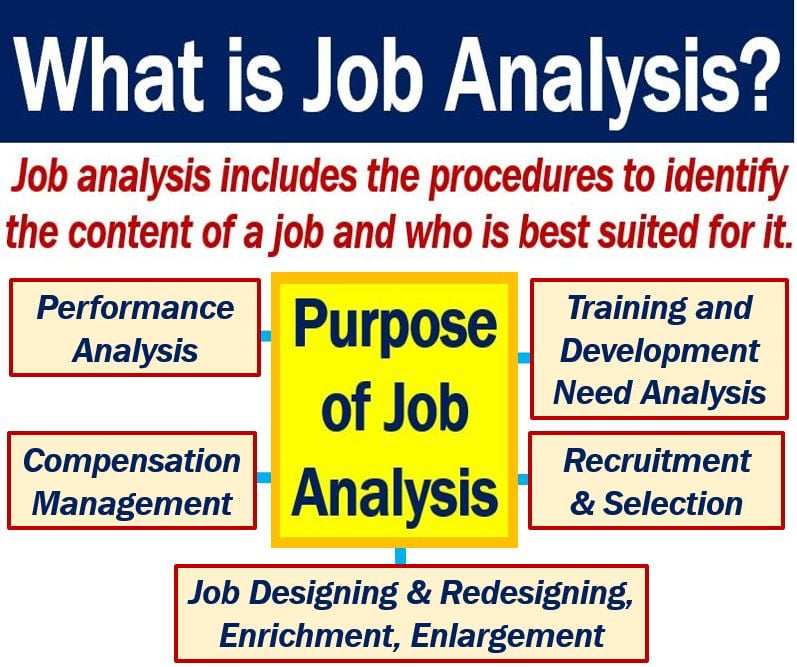Job analysis – definition and meaning
A Job Analysis is a process to carefully examine a job and determine what its duties and requirements are. We also call it Work Analysis. It includes determining how important the duties are, i.e., ranking them. The process also involves identifying the conditions under which the worker must perform those duties.
Strategically, job analysis plays a critical role in ensuring that organizational structure and growth align with long-term business objectives.
Additionally, job analysis includes listing what skills, attributes, and physical condition the employee must have. Specifically, the employee who does that particular job.
Carrying out a job analysis
When people carry out a job analysis, they gather and analyze information regarding the content and human requirements of a job. They also determine the context in which the worker must perform the job.
We use the process of job analysis to determine the placement of jobs.
Somebody who specializes in analyzing jobs is a job analyst.
TheBalance.com has the following definition of the term:
“A job analysis is a process used to collect information about the duties, responsibilities, necessary skills, outcomes, and work environment of a particular job.”
“You need as much data as possible to put together a job description, which is the frequent result of the job analysis.”
Job analysis is an important human resources function. ‘Human resources’ refers to the administration, hiring, and training of an organization’s workforce.
Job analysis and description
Before writing a job description, it is important to carry out a job analysis first.
A job description is a written summary of all the features of a job. The description gives an account of the employee’s duties, responsibilities, who they report to, and salary.
It also specifies what qualifications or skills the person who does the job must have.

Good job analysis is important
Not analyzing a job properly can lead to many unpleasant consequences. For example, if you hire the wrong type of person for a dangerous job, people could get hurt.
If you hire a sociophobic person with serious anger management issues as a night club bouncer, you will have problems.
Also, if you do not pay an employee the right salary, they might soon leave.
The process is useful in providing an overview of the basic requirements of any post.
The following outcomes are the result of carrying out a job analysis:
- Making plans for hiring and recruiting.
- Determining which positions must go if the company needs to reduce costs.
- Placing job ads.
- Performance development planning within a company’s performance management system.
Moreover, effective job analysis serves as a foundation for developing fair and equitable compensation plans that align with industry standards and organizational goals.
Job analysis procedures
There are two ways we can gather data on a job and determine the type of person the post requires.
-
Task-oriented procedures
These procedures concentrate on the activities involved in carrying out the work. It takes into consideration functions, responsibilities, and work duties.
Job analysts develop task statements which list the tasks that the employee must perform. They then rate the tasks according to their importance, frequency, and difficulty.
They also rate them according to consequences of error, i.e., what happens if somebody makes a mistake.
After rating the job’s duties, we have a greater sense of understanding of the job we are analyzing.
-
Worker-oriented procedures
These procedures focus on which human attributes are important for a particular job. We typically classify these attributes into four categories: knowledge, skills, abilities, and other characteristics. Some people refer to the four categories as KSAO.
According to Wikipedia:
“The KSAOs required for a job are inferred from the most frequently-occurring, important tasks. In a worker-oriented job analysis, the skills are inferred from tasks and the skills are rated directly in terms of importance of frequency.”
“This often results in data that immediately imply the important KSAOs. However, it can be hard for SMEs to rate skills directly.”
Some job analyses involve determining and then comparing levels of job satisfaction.
Brief history
The term ‘job analysis’ has its roots in the early 20th century and was shaped by the works of Frederick Winslow Taylor (1856-1915), Lillian Moller Gilbreth (1878-1972), and Morris Viteles (1898-1996).
Its main objective, understanding the behavioral requirements of work, has remained consistent through the years.
Video – What is a Job Analysis
This video presentation, from our sister channel on YouTube – Marketing Business Network, explains what the meaning of ‘Job Analysis’ is using simple and easy-to-understand language and examples.

